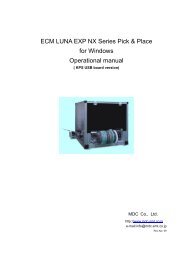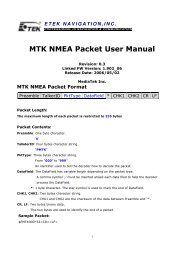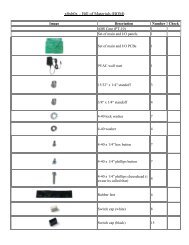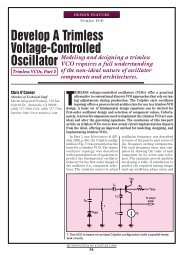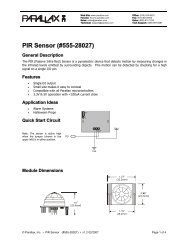Microstrip Patch Antennas for Broadband Indoor Wireless Systems ...
Microstrip Patch Antennas for Broadband Indoor Wireless Systems ...
Microstrip Patch Antennas for Broadband Indoor Wireless Systems ...
Create successful ePaper yourself
Turn your PDF publications into a flip-book with our unique Google optimized e-Paper software.
3.0 FOUNDATIONS FOR MICROSTRIP DESIGN<br />
A microstrip patch antenna is a radiating patch on one side of a dielectric substrate, which<br />
has a ground plane on the underside [1, pg-2]. The EM waves fringe off the top patch into<br />
the substrate, reflecting off the ground plane and radiates out into the air. Radiation<br />
occurs mostly due to the fringing field between the patch and ground.<br />
Ground<br />
plane<br />
<strong>Patch</strong><br />
Width<br />
Fig 1: Operations of a <strong>Microstrip</strong> <strong>Patch</strong><br />
Substrate<br />
The radiation efficiency of the patch antenna depends largely on the permittivity ( ε r ) of<br />
the dielectric. Ideally, a thick dielectric, low ε r and low insertion loss is preferred <strong>for</strong><br />
broadband purposes and increased efficiency. The advantages of microstrip antennas are<br />
that they are low-cost, con<strong>for</strong>mable, lightweight and low profile, while both linear and<br />
circular polarization is easily achieved. These attributes are desirable when considering<br />
antennas <strong>for</strong> WLAN systems. Some disadvantages include such as a narrow bandwidth as<br />
well as a low gain (~6 dB) and polarization purity is hard to achieve [2, pg-3].<br />
3.1 POLARIZATION TYPES<br />
This is the polarization of the wave radiated by the antenna in that particular<br />
direction. This is usually dependant on the feeding technique. When the direction is not<br />
specified, it is in the direction of maximum radiation [1]. Shown below are two most<br />
widely used polarization types.<br />
3.1.1 Linear Polarization<br />
A slot antenna is the counter part and the simplest <strong>for</strong>m of a linearly polarized<br />
antenna. On a slot antenna the E field is orientated perpendicular to its length dimension<br />
[3, pg-123]. The usual microstrip patches are just different variations of the slot antenna<br />
and all radiate due to linear polarization. Fig-2 illustrates the operations of a linearly<br />
polarized wave radiating perpendicular to the patch plane.<br />
3





